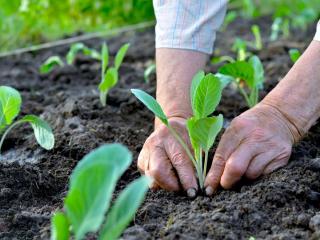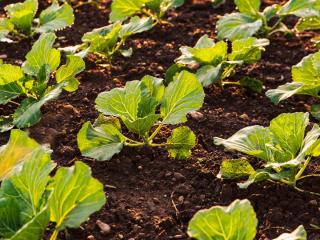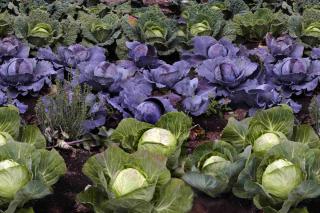

Cabbage is a vegetable that comes in many varieties and is very easy to grow.
Cabbage Patch Facts
Name – Brassica
Family – Brassicaceae
Type – biennial vegetable
Exposure – full sun
Soil – Cool, deep, moist and rich
Harvest – All year round depending on the variety
Special care, from sowing and planting to harvesting, will help you get magnificent cabbage.
 Cabbage comes in different varieties and each requires specific growing conditions and planting times.
Cabbage comes in different varieties and each requires specific growing conditions and planting times.
Headed cabbage (like white or savoy cabbage), Brussels sprouts, cauliflower and broccoli, here is how to grow them all.
If you choose and sow different varieties, you’ll be able to harvest cabbage from spring until the end of winter.
Sow headed cabbage at the end of winter or at the beginning of spring in a nursery.
Savoy and white cabbage can be started before kale.
Growing cauliflower takes much longer, since it needs nearly 7 months from seed to harvest.
Brussels sprouts are generally sown at the end of winter or in spring in a sheltered place.
 As soon as seedlings have sprouted at least 3 to 4 leaves, transplant them to their target location. Protect the cabbage seedlings if you need to plant before the month of May.
As soon as seedlings have sprouted at least 3 to 4 leaves, transplant them to their target location. Protect the cabbage seedlings if you need to plant before the month of May.
There are various types of pests that will attack your cabbages at all stages of life. Young ones are particularly vulnerable to snails and slugs. Older ones attract females of the large white, a butterfly that lays eggs on leaves for its caterpillars to feed on.
 Headed cabbage, both kale or white cabbage, need a few months to grow, but this span of time is highly variable, depending on the cultivar.
Headed cabbage, both kale or white cabbage, need a few months to grow, but this span of time is highly variable, depending on the cultivar.
Some varieties can be harvested 2 months after planting, whereas others need up to 7 months.
Wait for the head to have grown as large as a good-sized apple before harvesting your headed cabbage.
→ Tasty stuffed cabbage roll recipe with savoy cabbage
Brussels sprouts begin to ripen from the bottom up, as the main stem grows taller and taller.
You only need to break off a few of the largest tiny cabbage heads that grow along the side of it when you need a few. Don’t let get any larger than a ping-pong or golf ball, or they’ll get more and more bitter.
Cauliflower can be harvested practically all year round, depending on when they were sown.
Wait for the head to form well, then slice it off at ground level.
Broccoli is harvested when the main head is well formed and still tightly bunched.
Cut just about 2 inches (5 cm) below the harvested head, to let your broccoli grow on: it’ll grow a few more heads. They’ll be smaller, for sure, but just as delicious!
This takes place in fall until frost spells hit, and even winter if the climate permits (mild winters).
Slice the head off at the base with a very sharp blade.
Provide your cabbage with extra nutrients (fertilizer, manure and seaweed-based compost) to boost growth and enhance your harvest!